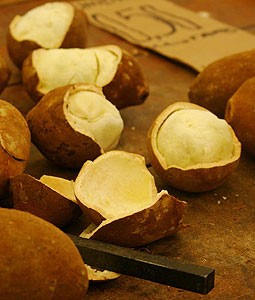Clara asks…What can you tell us about Cupuacu and the best place to buy it?
Cupuacu is a tropical fruit (or is it a nut?) that is similar to the cacao nut (or is it fruit?) According to those in the know, Cupauacu smells like a cross between chocolate and pineapple and tastes like pear mixed with banana. The pulp is rich in fatty materials (similar to cocoa butter) that make it an excellent moisturizer. In addition, research has shown that the seeds contain no less than nine known antioxidants (warning this list of chemical names may make your head spin just a little bit):
“(+)-catechin, (-)-epicatechin, isoscutellarein 8-O-beta-d-glucuronide, hypolaetin 8-O-beta-d-glucuronide, quercetin 3-O-beta-d-glucuronide, quercetin 3-O-beta-d-glucuronide 6′ ‘-methyl ester, quercetin, kaempferol, and isoscutellarein 8-O-beta-d-glucuronide 6′ ‘-methyl ester.”
Unfortunately it’s difficult to access the effect of antioxidants on skin so it’s unclear whether or not all these phyto-chemicals really provide an additional benefit. Still, this stuff smells great and it’s a great moisturizer so there seems little downside in trying it. (Assuming of course that there are no ethical sourcing issues – you know how sensitive our rainforests are!)
Where to buy?
Believe it or not, Amazon.com carries cupuacu butter. Use this link to buy Cupuacu (and support the Beauty Brains in the process.)
Image credit: https://c1.staticflickr.com/5/4097/4879170540_f4baa12052.jpg
Reference:
J Nat Prod. 2003 Nov;66(11):1501-4. New bioactive polyphenols from Theobroma grandiflorum (“cupuaçu”). Yang H, Protiva P, Cui B, Ma C, Baggett S, Hequet V, Mori S, Weinstein IB, Kennelly EJ.

